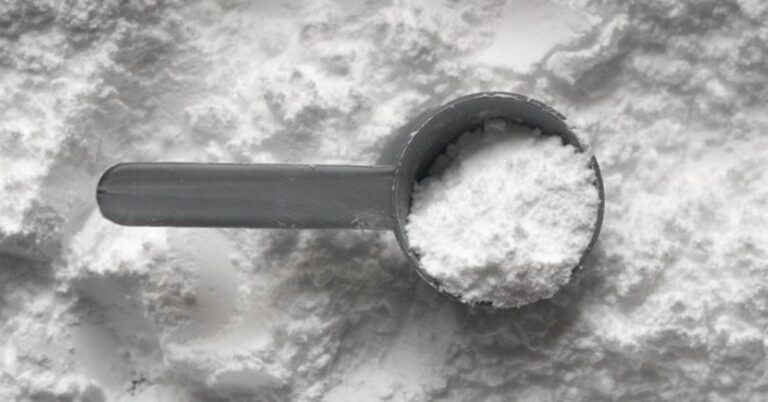Ever woken up after a heavy chest and tricep day, feeling a soreness in your arms that makes you wonder if you should skip the gym?
Working out when you’re sore can be a tough one. Your triceps are sore to the touch and now, you’re wondering if it’s a good idea to train your biceps.
The good news? Training your biceps while your triceps are sore is generally safe, and it can actually contribute positively to your workout routine.

In fact, your biceps and triceps are classic examples of antagonistic muscle groups; meaning while one contracts, the other relaxes.
This natural muscle interaction suggests that exercising your biceps could actually be beneficial for your sore triceps. It could encourage blood flow to the area, helping to deliver essential nutrients and speed up recovery.
So, let’s look at why it’s generally fine to proceed with your bicep workout with sore triceps, and how to make sure you’re not stunting your recovery.
Key Takeaways
- Training biceps with sore triceps can aid recovery by promoting blood flow.
- Biceps and triceps are antagonistic muscles, so working one can rest the other.
- Gentle, targeted bicep exercises can minimize stress on sore triceps.
- Proper recovery methods and paying attention to pain levels are crucial.
Understanding Muscle Soreness
When you challenge your muscles with a tough workout, soreness can be a natural response. It’s your body signalling that it’s hard at work repairing and strengthening your muscle fibres. Let’s understand why you feel muscle pain after a workout.
Types of Muscle Soreness
There are generally two types of muscle soreness: acute soreness and delayed onset muscle soreness (DOMS).
Acute soreness is felt during or immediately after exercise. It’s what you might call the “good burn” when your muscles are firing up.
On the other hand, DOMS is the pain and stiffness that can be felt hours to days after unaccustomed or strenuous exercise.
This is your classic ‘next-day’ soreness that can make going down stairs or grabbing a cup a delicate task.
What is DOMS?
Delayed Onset Muscle Soreness (DOMS) is the technical term for the pain and stiffness in your muscles that you feel anywhere from 24 to 72 hours after exercise.
It occurs when you give your muscles a new challenge—they might stretch more than usual, lift heavier weights, or work for longer.
During these challenges, microscopic tears occur in the muscle fibres, which then triggers a response from your body to repair and build them back stronger. This is the basics of muscle hypertrophy.
Identifying Symptoms of Muscle Soreness
You’ll know when you have muscle soreness. Your arms may feel tight, tender to the touch, and movement might be a bit more difficult than usual.
The symptoms of muscle soreness can range from a mild, tender sensation to severe debilitating pain. The effects might include:
- Swelling in the exercised muscle
- Reduction in range of motion due to stiffness
- Temporary reduction in muscle strength
- Aching or sharp muscle pain when you touch your muscles, move, or even at rest
If your triceps are sore, you might notice discomfort when you try to extend your arm or perform pushing movements.
Sometimes, you’ll find doing simple things like reaching for a mug on a high shelf can prove trickier when you’ve worked your triceps hard.
You might see a bit of swelling too—that’s your body working to repair those those micro-tears.
Remember, though, muscle soreness is temporary and usually subsides as your muscles adapt and strengthen with consistent exercise.
Causes of Soreness in Triceps
Your triceps, the muscles at the back of your upper arms, can get sore from lots of different exercises.
Muscle soreness is primarily caused by exercise-induced muscle damage (EIMD).
When you engage muscles, especially during high-intensity strength training or new activities, microscopic tears occur in the muscle fibres.
The body’s response to these tears and the inflammation that follows can lead to soreness.
Things like lifting heavier weights, increasing your running distance, or doing a heap of tricep dips can all be culprits of this kind of soreness.
Maybe it was those excessive bench dips or those overhead triceps extensions that did it.
As your triceps adapt, they’ll become more resilient and less prone to inflammation and soreness.
But, if the pain is intense and doesn’t reduce after a few days, it’s a sign your body needs a rest or you might need to check in with a healthcare professional to ensure everything’s okay.
Know The Difference Between Pain And Injury In Your Triceps
Not all tricep pain is down to DOMS.
There are a few occasions where you may experience an actual muscle tear or tendon injuries.
Common Causes of Tricep Injuries
Injuries to the triceps tend to occur from either sudden injury or overuse.
Lifting heavy objects or overdoing exercises can lead to strain, where the muscle fibres experience small tears (much larger than the micro-tears involved in muscle hypertrophy).
Overuse might also result in tendonitis, which is the inflammation of the tendons.
Sudden injuries can cause more severe problems such as a tendon rupture, which typically requires medical intervention and can be identified by a gap in the muscle.
What Is Triceps Tendonitis?
Triceps tendonitis is inflammation and irritation of the triceps tendon.
This condition often stems from repetitive motions that put strain on the triceps, like throwing a ball or performing bench presses.
Symptoms include pain, weakness, and sometimes swelling in the upper arm.
Treatment generally involves rest, ice, and anti-inflammatory medication, with an emphasis on gradual return to activity to allow proper healing of the connective tissue.
Benefits of Training Biceps During Triceps Soreness
When it comes to lifting weights and building muscle, understanding how your muscles work together or against each other can be massively beneficial to your workouts and recovery.
Understanding how your muscles work together or against each other can be massively beneficial to your workouts and recovery. With antagonistic muscle groups, like the biceps and triceps, you can train one muscle while the other is recovering also known as active recovery.
How Biceps Exercises Can Promote Recovery in Sore Triceps
Antagonistic muscle pairs like the biceps and triceps can usually allow for active recovery. Essentially, when you flex your biceps, the triceps relax, and vice versa.
This relationship means that exercising your biceps should not cause additional strain or soreness in your triceps, allowing for muscle opposition to be used for recovery and growth.
The key is knowing that engaging in a biceps workout while your triceps are sore might actually benefit you.
Working your biceps stimulates blood flow in the upper arm, facilitating recovery and nutrient delivery to the achy triceps.
As you focus on moves like a dumbbell curl, your triceps get a chance to relax, but the increased circulation helps bring in fresh oxygen and nutrients that edge forward the healing process.
So, when you’re dealing with that tender feeling post-triceps day, it’s okay to switch focus to their antagonistic partners, your biceps, without worrying about causing harm.
This allows for concurrent training – a method where you can train different muscle groups in the same workout – to come into play. This approach not only optimises your time in the gym but also ensures your functionality during soreness isn’t hindered.
Remember, just because one side of your arm is sore, doesn’t mean you have to lay off the weights altogether – the right balance of movements can stimulate recovery, all while you keep making those gains.
Recommended Bicep Exercises That Avoid Tricep Activation
To focus on bicep growth without overloading sore triceps, consider exercises that isolate the biceps:
- Dumbbell Curls: Stand with your feet shoulder-width apart, dumbbells at your sides. Curl the weights towards your shoulders while keeping your elbows still.
- Hammer Curls: Similar to dumbbell curls but with your palms facing each other, hammer curls target the biceps in a slightly different way.
- Preacher Curls: Using a preacher bench helps you to isolate the biceps by preventing movement from the shoulders.
By opting for exercises that target your biceps with minimal triceps involvement, you should be able to exercise without putting stress on your sore triceps.
Moves like hammer curls and concentration curls are spot-on choices. They allow you to work your biceps efficiently without engaging the sore triceps, preserving your arm workout balance and promoting arm growth.
Low-Impact Exercises to Promote Muscle Recovery
Low-impact bicep exercises provide a workout that doesn’t aggravate your triceps.
Consider using resistance bands or lighter weights for your biceps routine, which still gets blood pumping but keeps the strain off your sore triceps.
This approach to exercise benefits the whole arm by fostering muscle adaptation and an overall balanced workout, even when part of your musculature is in recovery mode.
Treatment and Recovery
Recovering from exercise is hugely important for avoiding injury and maintaining a consistent training schedule.
There are a few ways you can help to manage soreness and aid your recovery.

RICE Method
Rest, Ice, Compression, and Elevation (RICE) are your first go-to steps when you’re dealing with muscle soreness. Here’s how each element helps:
- Rest: Take a break from activities that strain your triceps to prevent additional harm.
- Ice: Applying ice can reduce swelling and alleviate pain.
- Compression: Wear a compression bandage to minimise swelling.
- Elevation: Raising your arm above heart level can also help decrease swelling.
Medications and Therapies
Over-the-counter anti-inflammatory medications, like ibuprofen or aspirin, can relieve pain and reduce swelling.
Nutrition for healing is important, with a focus on protein and antioxidants to repair muscles and reduce inflammation.
Don’t forget hydration; drinking plenty of water is essential to help flush out toxins and aid in muscle recovery.
In some cases, healthcare professionals may suggest NSAIDs or corticosteroid injections to manage severe inflammation, while platelet-rich plasma (PRP) therapy might be an option for tissue healing.
Rest and Sleep
When it comes to rest and sleep, there’s no substitute.
Your body does its best recovery work when you’re asleep.
Aim for 7-9 hours of quality sleep to give your muscles, including those sore triceps, the best chance to repair and strengthen.
During sleep, blood flow increases to your muscles, which is prime time for recovery and reducing muscle soreness.
- Sleep: 7-9 hours for optimal muscle repair
- Rest Days: Schedule them in to prevent overtraining
Stretching To Aid Recovery
When your triceps are sore but you’re considering a biceps workout, it’s important to focus on stretching and mobility exercises as an integral part of your training routine.
These practices can enhance muscle function and potentially reduce soreness.

Dynamic Stretching for Warm-Up
Before starting your biceps routine, engaging in dynamic stretching is a smart move.
This activity prepares your muscles for action by increasing blood flow and improving range of motion.
Make dynamic stretches movement-based; for example, arm circles or gentle swinging can prepare both your triceps and biceps for the workload ahead.
- Arm Circles: Extend your arms out to the sides and make small circles, gradually increasing in size.
- Swing Arms: Gently swing your arms across your body and over your head in a controlled manner.
Both exercises are excellent for loosening up, especially when dealing with residual tricep soreness.
Post-Workout Static Stretching
After pumping your biceps or triceps, don’t forget to cool down with static stretching to aid in recovery and flexibility.
This part is crucial – it’s where you take the time to lengthen the muscle fibres, increase blood flow and encourage relaxation. A classic is the overhead triceps stretch, where you can directly address the sore tricep muscles:
- Raise one arm overhead and bend it so your hand reaches towards the opposite shoulder blade.
- Use your other hand to gently press on the bent elbow, intensifying the stretch.
Hold this position for about 15-30 seconds before switching sides.
Besides aiding in mobility, focusing on the elbow extension during the stretch helps in maintaining a balanced range of motion, essential for overall arm health and function.
Remember, stretching isn’t just a preliminary activity; it’s a core part of sustaining your muscle health and workout effectiveness. Always give it the attention it deserves!

Can You Train Biceps with Sore Triceps?
The short answer is yes, you can train your biceps even if your triceps are sore.
Biceps and triceps are opposing muscle groups; when you flex one, the other relaxes. So, working out your biceps shouldn’t cause any further tricep soreness.
In fact, it might even help by promoting blood flow to the arm, which can aid in recovery.
However, pay attention to what your body is telling you – if your soreness is extreme, it might be worth resting a day before hitting the weights again.
Remember to consult with healthcare professionals if you experience severe pain or symptoms that indicate a more serious injury.
By understanding the balance between exercise and recovery, you can continue to make gains in your fitness journey while taking care of your body.
Your biceps can still get a good workout in, even when taking it easy on the triceps.







